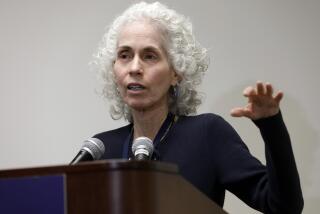Hospitals May Fail to Meet Nurse-Staffing Standard
- Share via
A panel of medical experts warned Thursday that Los Angeles County hospitals may not be able to recruit enough nurses to comply with a new state law.
After a four-hour hearing, the county’s Emergency Medical Services Commission voted to seek temporary relief from the law, set to take effect Jan. 1. Signed by Gov. Gray Davis four years ago and debated ever since, the legislation seeks to improve care by limiting the number of patients assigned to each nurse.
Under the new rules, each nurse would have no more than eight patients at a time, and in many hospital units, the limit would be four to six patients.
The measure was sponsored by the California Nurses Assn. and heralded by many overworked nurses but opposed by the hospital industry, which called it costly and intrusive. The state Department of Health Services has estimated that the new regulations would cost hospitals roughly $480 million a year.
On Thursday, some hospital officials suggested asking the state for more time to phase in the staffing ratios, cautioning that a nationwide shortage of nurses may lead hospitals to close units they cannot adequately staff.
“We think this is going to be, at least in the short term, a train wreck,” said James Barber, president and chief executive of the Hospital Assn. of Southern California. “It wouldn’t surprise me at all if every hospital was out of compliance on some shift on some wards at least once a week.”
Many nurses insist that the new staffing ratios will entice people to join their profession because workloads will be more manageable and patients safer. Already, California has increased the capacity in its nursing programs and added more than 30,000 licensed nurses to the work force since the law was signed, according to the nurses association.
Hearing hospitals say , “ ‘We need to phase it in; it’s just hitting us too hard,’ ... makes us a little cynical,” Jill Furillo, a veteran emergency room nurse who works as a lobbyist for the California Nurses Assn., told the hearing. “The hospitals have known about this for years.”
Dozens of nurses seated in the audience, many of them still dressed in their scrubs, cheered her on. Without the ratios, Furillo predicted, “the nurses will leave your hospitals in droves.”
The EMS Commission’s request to delay implementation of the ratios now goes to county supervisors, who will decide whether to forward it to Sacramento. The only supervisor who addressed the commission, Gloria Molina, said she supported the move.
It remains to be seen how Gov.-elect Arnold Schwarzenegger, set to take office next week, would view such a request. A spokesman said that Schwarzenegger has not yet taken a position on the staffing ratios.
The ratios are just one strand in the county’s troubled network of emergency care, an assortment of 39 paramedic agencies serving 81 hospitals and 13 trauma centers. Complaints were abundant during the hearing, about problems including hospital closings, greedy health-care executives, low Medicaid reimbursement rates, the rising number of patients without health insurance and emergency rooms so crowded that sick and injured people routinely wait hours to be treated.
But ready solutions -- and the millions of dollars needed to fund them -- were scarce.
Dr. Robert Hockberger, the director of emergency services at Harbor-UCLA Medical Center, put it bluntly: “I don’t have any answers for you,” he told the commission.
Instead, Hockberger recounted a recent overnight shift in which he arrived to find every available bed filled and 54 patients waiting in the emergency room. Some had been waiting for 12 hours, leaving doctors and nurses to treat people as they stood in hallways.
“We’re jamming patients, much to the nurses’ dismay, into every nook and cranny we can find,” he said.
Meanwhile, more than 150 licensed beds at his hospital remain empty for lack of money to hire workers to staff them.
More to Read
Sign up for Essential California
The most important California stories and recommendations in your inbox every morning.
You may occasionally receive promotional content from the Los Angeles Times.













